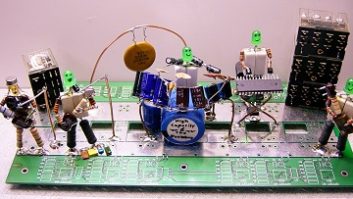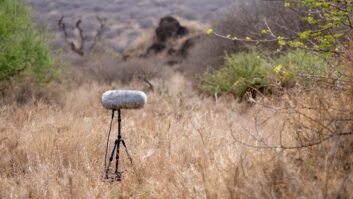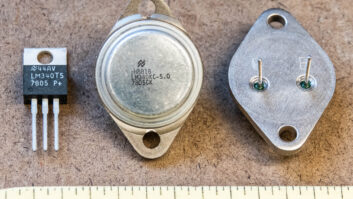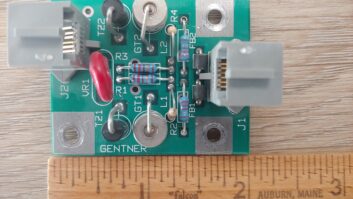Fellow “Star Trek” fans will no doubt recognize the Borg title of our column. But the resistance I’m going to talk about is the resistance in speaker cables.
Resistance generally has the same effect at all audio frequencies. High resistance will waste the power from your amplifier by turning it into heat. The output of an amplifier can be anywhere from a watt or two to hundreds, even thousands of watts. The key is to have low resistance so that all energy is transferred.
Just remember, you have two wires to each speaker, and you must multiply it by the number of feet from your amp to the speaker.
How much resistance is too much? Well, it’s a bit more complicated than that. What gage should you use? Larger cables, 10 AWG or 12 AWG, are the most popular choices.
I can tell you that the most popular size sold is 12 AWG. There’s a survey on my employer’s Web site that indicates that 10 AWG is the favorite with the high-end audio crowd, with 12 AWG a close second. These gage sizes are good compromises among low resistance, size and cost.
(To see the whole survey go to www.belden.com, choose “cable college,” select “technical papers” and find the one at the bottom called “Rec. Audio.High-End Speaker Cable Design Project.” You have to scroll down to the survey results.)
Important parameters
You could, of course, use welding cable. That would be super-low resistance.
But is this necessary? I think we need to visit more specs before we can assign a “most important” label to any particular parameter.
In terms of wire gage, which is really the same as resistance, we have another factor to consider: slew rate. Slew rate essentially addresses the amplifier’s ability to pass high frequencies, where waveforms are very fast in “risetime.”
The slew rate is the ability of the amplifier, and the speaker attached to it, to “track” these fast-moving waveforms and reproduce them accurately. Slew rate is determined by the total impedance of the speaker, which we hope is something close to the 4 or 8 ohms written on it, with the added resistance of the speaker cable, divided by the output impedance of the amp.
The output impedance of modern amplifiers is low, often tenths of an ohm or even lower. Because the slew rate is the speaker impedance plus wire resistance divided by amplifier’s actual output impedance, this can give you slew rates into the hundreds, sometimes even in the thousands.
In addition, you can see that the resistance of the speaker cable can be a factor in determining the amp’s ability to deliver fast waveforms to the speaker.
Of course, the actual impedance of a speaker changes with frequency. Some have dips as low as 2 ohms; some have peaks into double-digits. This means that slew rate must include the question, “At what frequency?”
Because low frequencies are relatively easy to pass, compared to highs, you really need to specify a high frequency, say, 20 kHz. If your slew rate is poor here, you easily can calculate the difference that lower resistance (i.e. larger) speaker cable would make.
So what is a good slew rate? Or maybe the question should be “What’s a good slew rate at 20 kHz?”
I’d love to know the answer. My e-mail address is at the end of the column. Maybe speaker or amplifier manufacturers have an opinion or two to throw our way.
Bigger is better
Because the resistance of the cable is added to the speaker impedance, the cable can be a serious factor, so you want to keep the resistance low. The result of all this is that bigger wire is better than smaller wire, which is exactly where we started. This is true especially when you consider that large amplifiers can deliver a considerable amount of current to a speaker.
A 100-watt amp into a 4-ohm speaker means that 5 amps flows down the line. A 500-watt amp produces 11 amps. This also justifies large-gage, low-resistance wire.
Now don’t send me e-mails telling me that, especially in the home environment, most amplifiers are rarely working past 1 watt. Sure, unless you have a super-inefficient speaker, or you’re filling an auditorium at rock-band volume, you don’t need tons of power.
It is interesting to note that, when the “talkies” came to movie theaters in the late 1920s, the amplifiers used were rarely more than 10 watts, and often only 5 watts. Nevertheless, that was enough to have a large room filled with sound.
Forget the wires
Also on the Belden Web site is a chart showing how far you can go with different gage wires and different speaker impedances.
For higher-impedance speakers and larger-gage wires, you can get up to a couple of thousand feet, provided you don’t mind losing a chunk of power in the wire itself. The chart is at http://bwccat.belden.com/Bimages/TechInfo.htm, choose “multiconductor and paired cables,” then choose “speaker cable” from the “audio/video cables” selection.
Then there is a column that says “70-volt speaker” with distances up to 56,000 feet. Yes, this is no misprint: over 10 miles. How is this possible? It’s simple: change the impedance of the system so that the resistance of the wire is inconsequential.
Buy an amplifier with a 70-volt output and a small transformer for every speaker. These transformers are available at different wattages depending on how much power you expect to send to each speaker. These transformers have a 70-volt primary, for the incoming signal from the amp, and an 8-ohm secondary, for the speaker side.
One of the advantages to this system, besides the distance, is the ability to select the relative level on each speaker. Most 70-volt transformers for the speaker have power taps. If it’s a 10-watt transformer, for instance, the taps might be 1 watt, 2.5 watts, 5 watts and 10 watts. If you choose the 5-watt tap for that speaker, it will be 3 dB down (half power) compared to a speaker wired to the 10-watt tab on its transformer.
We’ll continue next time with more on 70-volt distributed loudspeaker systems, and look at other parameters in speaker cable such as capacitance.












